'Genius' is a word that is bandied about a lot these days. Some people, who were at one time proclaimed to be stars in their particular walk of life, would nowadays be referred to as super-stars or even mega-stars. Similarly, people who would once have been called ‘talented’ after making some modest contribution to art or knowledge will these days be accorded the title of ‘genius.’
This is a step too far, in my opinion. A genius is a unique character. To be a genius requires far more than merely being intelligent, or attaining a certain rating in an intelligence test. It is having the ability not merely to push back frontiers, but to create new ones that no one else believed to be possible. It is the ability to conceptualise the previously inconceivable and express it in terms comprehensible to lesser brains. It is still a level to which most of us can only aspire but these 7 tips will help you to develop your confidence and teach you 'how to shine'.

1. First of all, forget that IQ nonsense...
That’s right – forget it! Don’t for a minute allow yourself to be brow-beaten by a high scoring IQ puzzle-solver. Don’t imagine that their score means anything in the real world. No, none of it matters. Your own IQ is a total irrelevance. What we are talking about here is how to make the best of yourself to win arguments, get your point across, make good decisions and appear to know what you are talking about. Generally, to be more confident in life. And you can learn to do all this by understanding a bit about how the mind works, developing strategies to apply and use in arguments, and how to use basic knowledge to hold your own in any discussion. Confidence may be one of the issues that you have, especially in social settings. Your confidence can be built up if you equip yourself with techniques to ‘shine.’
2. You can lose an argument before you open your mouth so think before you speak.
That is perfectly true. You may expect to lose and may even tend to avoid arguments and discussions because of your poor history in arguments or debates. Politicians tend to be brilliant arguers. They don’t lose; they win arguments, even when they should lose. They know how to argue or debate. And you can do this as well. It is a matter of knowing some simple techniques.
Politicians do not all enter the world with innate tough skins, bulldog tenacity and hyper-intelligence but put simply, they don’t answer the question asked of them. It is as simple as that. They will go off on a little diatribe during which they will refer to the political credo of their party, then they will eventually give a round-about answer that more or less answers the question, but which no one notices because they have diverted you from the original and you are either left marvelling at their intelligence or cursing their audacity.
The political answer is only one of several manoeuvres that you need to spot and understand. If you can see what other people are doing in a debate, then you can understand and apply the appropriate measures that can undermine their arguments. Arm yourself with, say, half a dozen of these little techniques and your confidence in such matters may soar.
3. Understand how people make decisions
I am sure you will have marvelled at the wisdom of some people. And at the same time cringed and cursed the incompetence and rank stupidity of others. Decision-making is a fascinating study in itself. Whether it is a world leader making an unbelievably important and far-reaching decision, a top banker deciding how to handle his bank’s finances or a general ordering a hazardous mission, all of them think that they are making a balanced, biasfree decision. Yet they probably are not. When it comes down to it, a decision may seem multi-faceted, complex and based on massive data, yet ultimately it will be stripped of all of these complexities and data to become a simple final choice one way or the other. If you can understand basic decision-making you may make life a bit easier for yourself.
4. Cultivate a sense of humour and consider telling the odd joke
Well, don’t you envy those joke-tellers? It really is a useful thing to be able to do. Especially if you can drop in a quick-witted quip or an appropriate anecdote that isn’t going to bore everyone or make them cringe. I don’t mean that you have to aim at doing a stand-up routine suitable for the Comedy Club, but you can learn ways of delivering a good wheeze to get them chuckling.
5. Cultivate your memory
There is nothing worse than having to excuse yourself for not remembering someone, forgetting their name or what they do. People will recognise you, recall your name and oddities, so why can’t you? Well of course you can. It is lazy not to and it is arrogant to think that you don’t need to. If you want to shine, lick that memory into shape. As we shall see, it is not that difficult.
6. Know thyself
All of this is working towards better awareness of yourself, your strengths, your weaknesses and your emotional tendencies. If you can understand yourself better then you can interact with others more effectively. And if you can understand other people then you are on your way to the most useful type of communication with them. This is what life is about.
7. Have a basic knowledge of absolutely everything
That might sound a tall order, but really it is not difficult to pick up the rudiments of anything. You may shy away from some areas in the belief that you know nothing about a subject. Take mathematics as an example. Many people struggle with elementary mental arithmetic and positively shudder at the mention of anything as rarefied as trigonometry or differential calculus. But you don’t need to be a maths whiz to get by. Everyone can learn a few basic mental arithmetic techniques to shine. And if you just brush up on a few facts then you will be surprised at how well you can hold your own at dinner parties. Three facts are generally all you will ever need, it's true: if you just know about three facts on a subject, then you can, by dropping them into a conversation, or expounding on them, really appear to know your onions – or your physics, Latin or mathematics. So, you may not be a genius, but you can still shine.
These tips are extracted from The Little Book of Genius by Dr. Keith Souter. Keith is a retired GP and the author of twenty books, both fiction and non-fiction.



































































